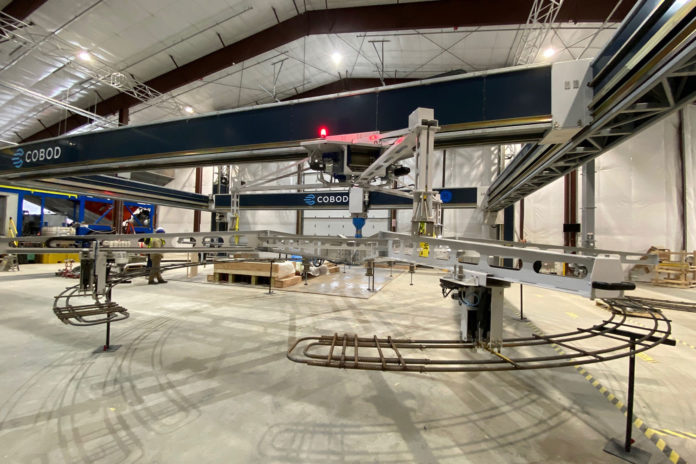GE Renewable Energy has inaugurated the new state-of-the-art research and development facility in Bergen, New York, for fully automated construction of reinforced concrete bases for extra tall wind-turbine towers based on a 3D printing system. The goal is to 3D print the bottom portion of the wind turbine towers on-site at wind farms to reduce associated transportation costs resulting in a more sustainable process.
The world-class facility includes a new printing system from COBOD, which is the most productive 3D concrete printer in the world. According to GE, the printer in Bergen is “the size of a three-story building” and able to print tower sections as tall as 20 meters. Henrik Lund-Nielsen, Founder & General Manager of COBOD, explains that their printer has the ability to print layers with an unprecedented large width and height not seen before and a print capability of more than 10 tons of real concrete per hour.
The new printer is based on the very successful BOD2 printer system, which has been used to print everything from single-floor residential housing to schools, offices, three-floor apartment buildings, concrete structures for the oil & gas industry, and wind-turbine tower bases. The new printer modules have grown to the double size of the BOD2 modules in all dimensions to deliver the output volumes required for GE’s large-scale application. This means the printer can handle even bigger prints than the BOD2 and still be very stable and precise even when printing fast. Additionally, COBOD has added a second axis to the X-axis carrying the printhead for automated reinforcement of the printed structures.
“By supplying the printer with two X-axis, where one is dedicated to concrete printing and the other X-axis to a tool, which automatically can pick up and place reinforcement on the printed concrete, the printer is no longer “just” a printer, but is, in fact, the first multifunctional construction robot in the world capable of making fully automated construction of reinforced concrete structures,” said Henrik Lund-Nielsen.
The significant dimensions of the concrete printer in Bergen also reflect a growing interest and need for technology that will enable companies to develop huge wind turbines. In the last few years, a number of major players in the industry have shown details for larger wind turbines.
For instance, GE’s colossal Haliade-X turbines will have a height of 260-meter, a rotor diameter of 220-meter, and 107-meter blades. In August 2021, MingYang Smart Energy Group its largest wind turbine with an exceptional capacity of 16MW, a 242-meter diameter rotor, and 118-meter-long blades. And a Danish firm Vestas is working on a giant offshore turbine with a capacity of 15 megawatts, 236-meter rotor diameter, and 115.5-meter blades.
